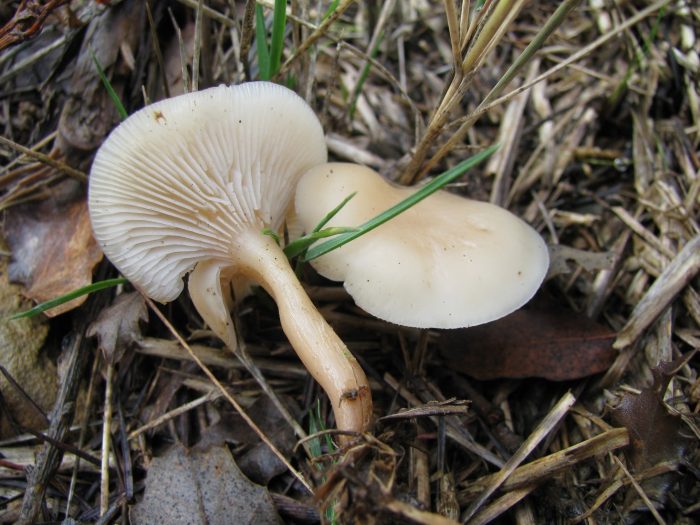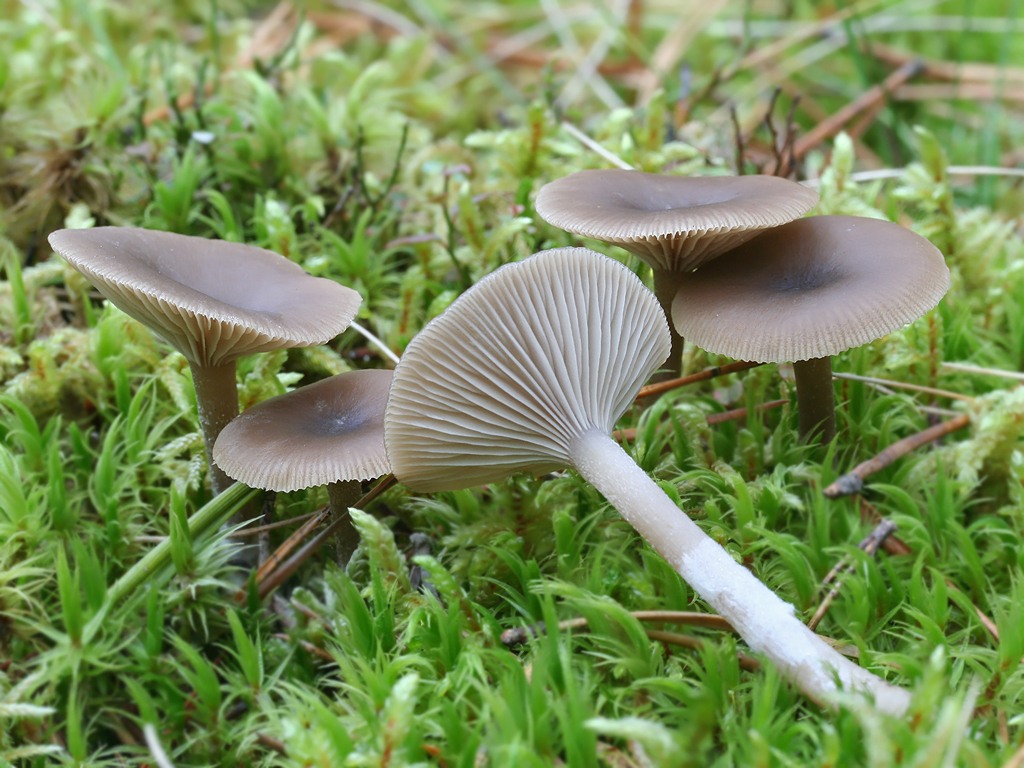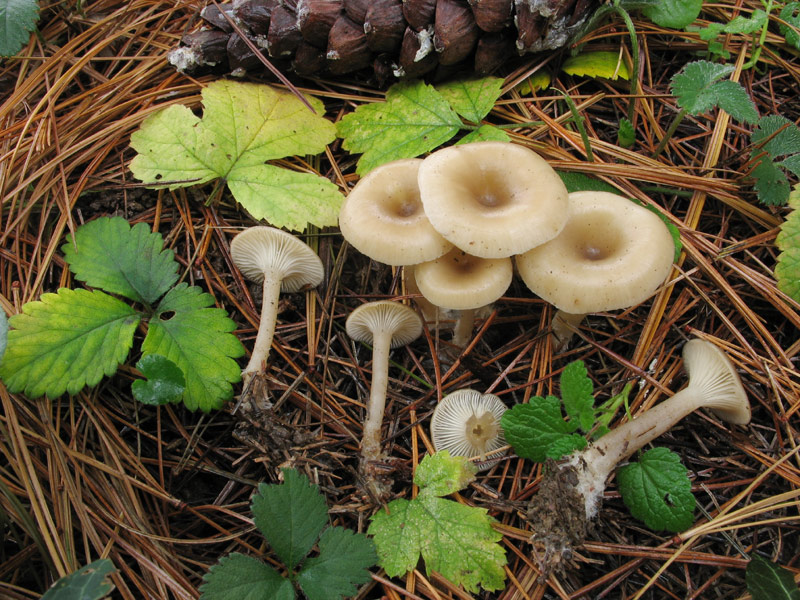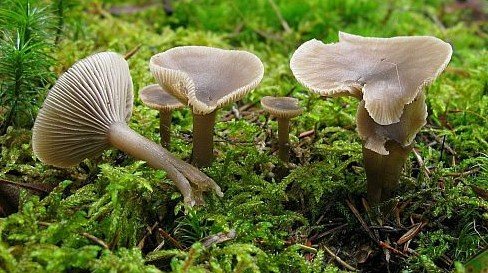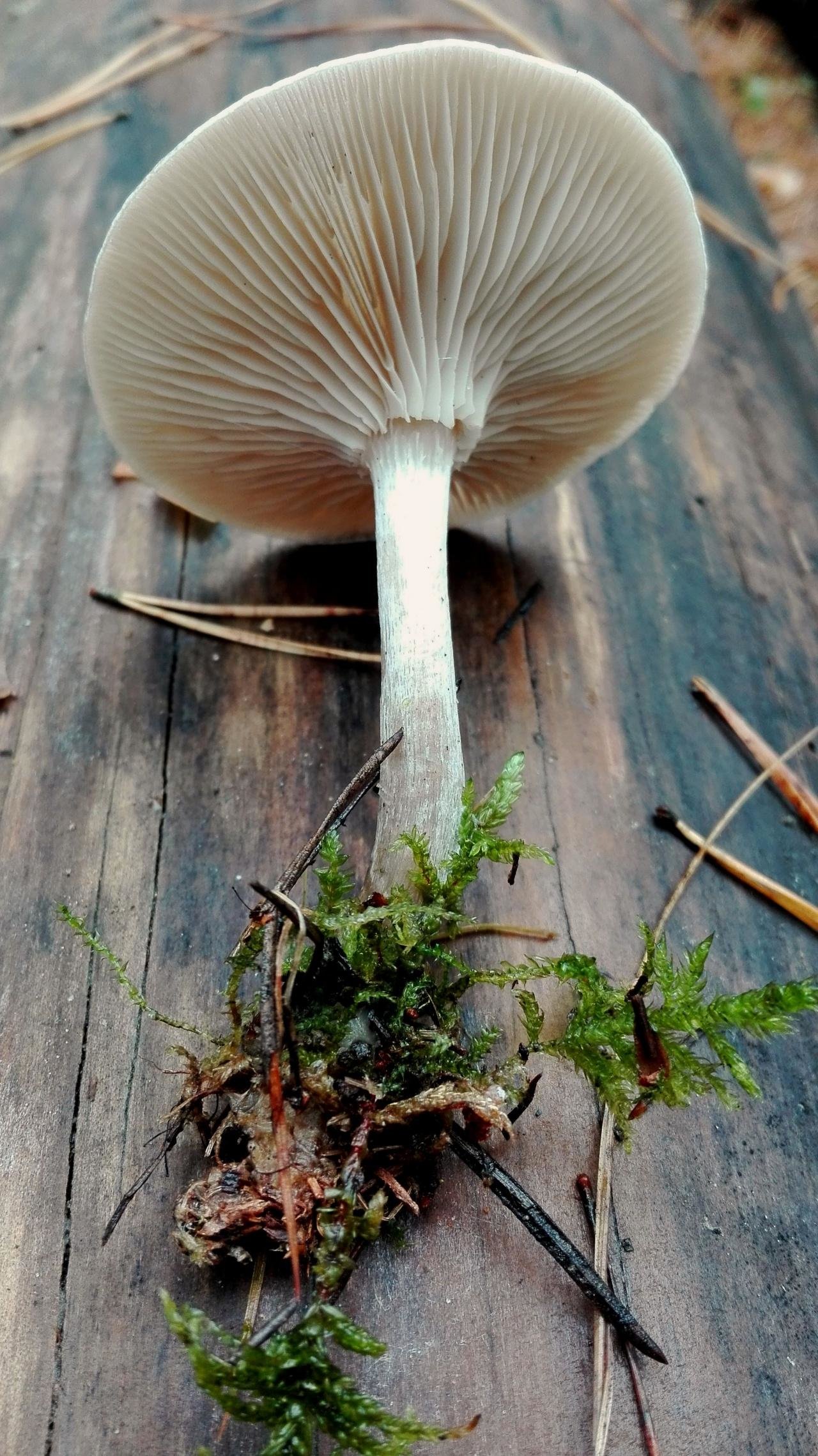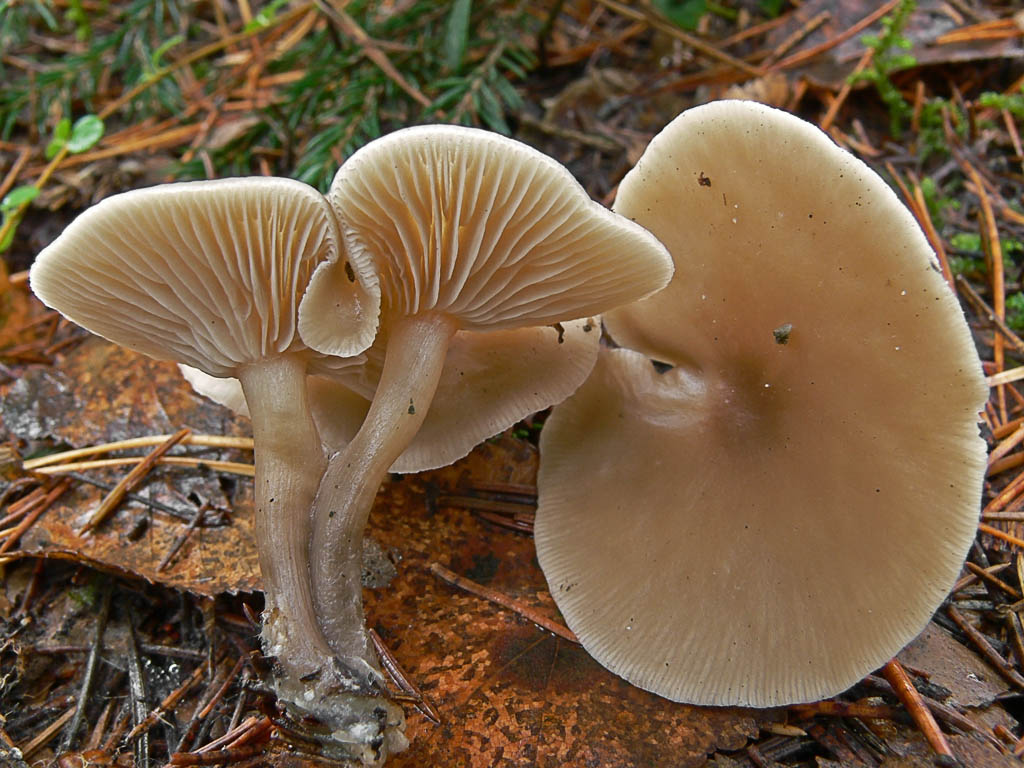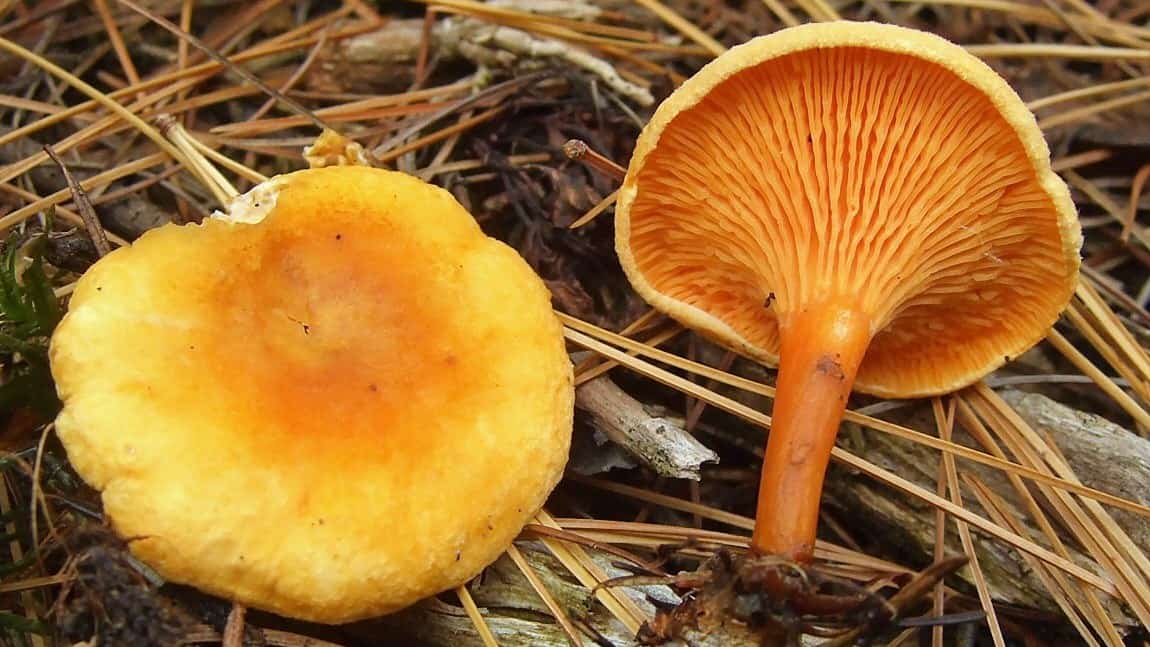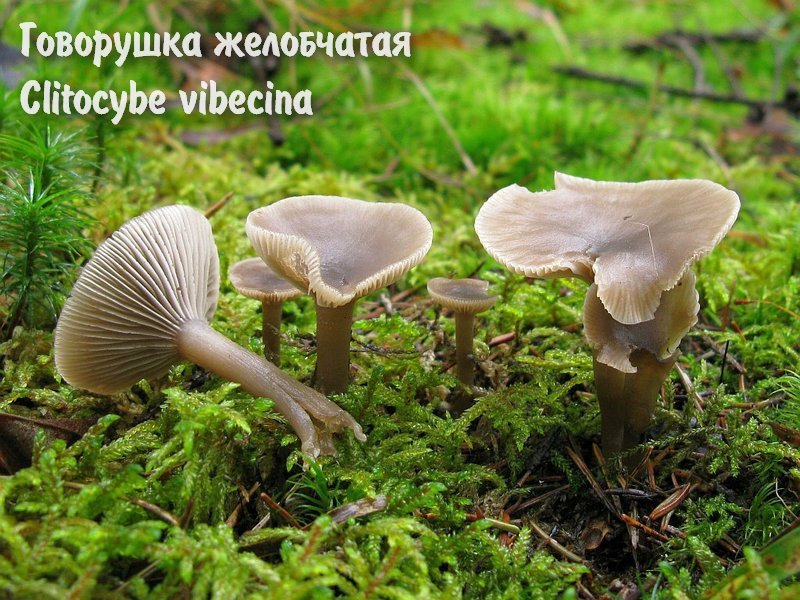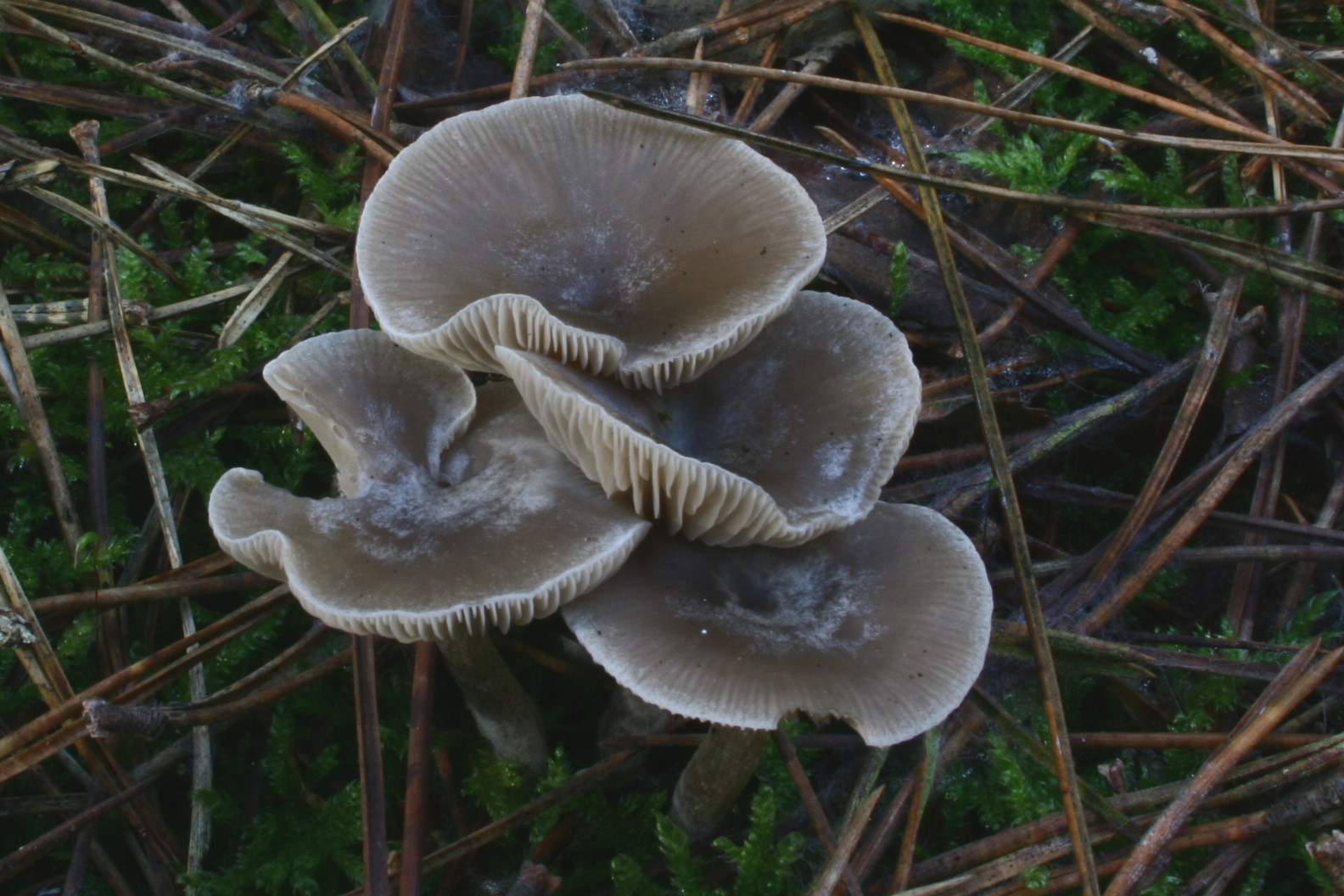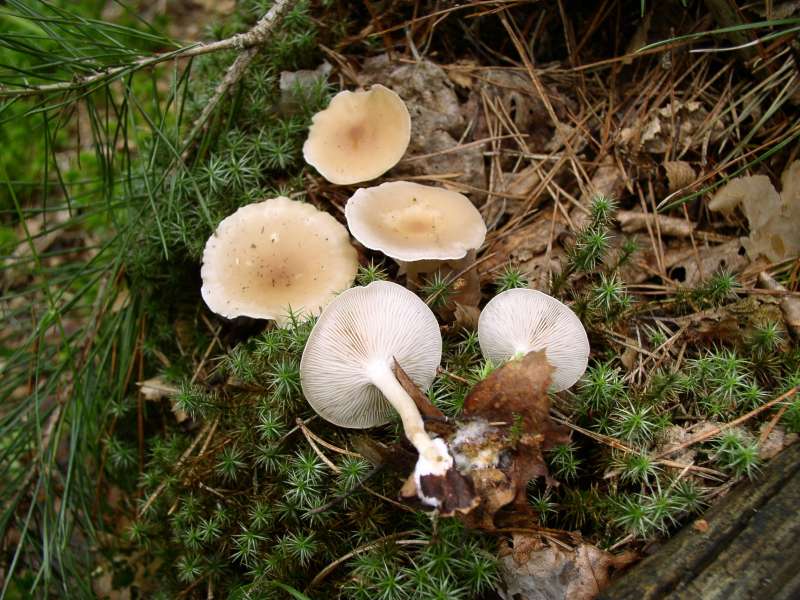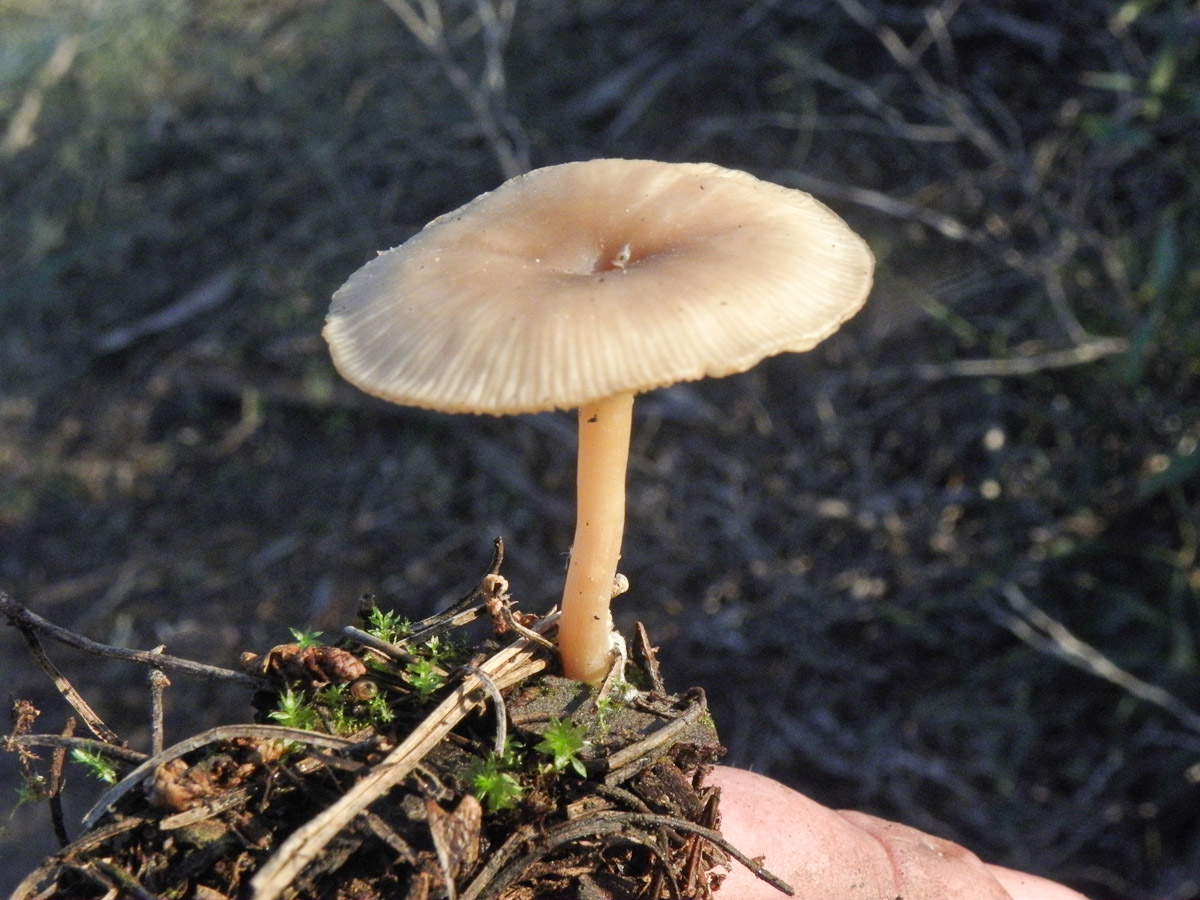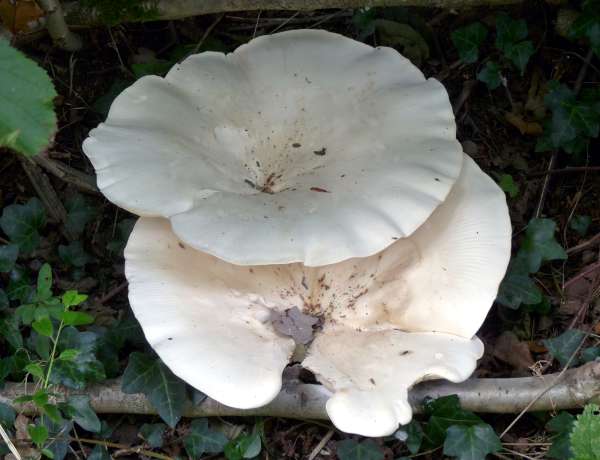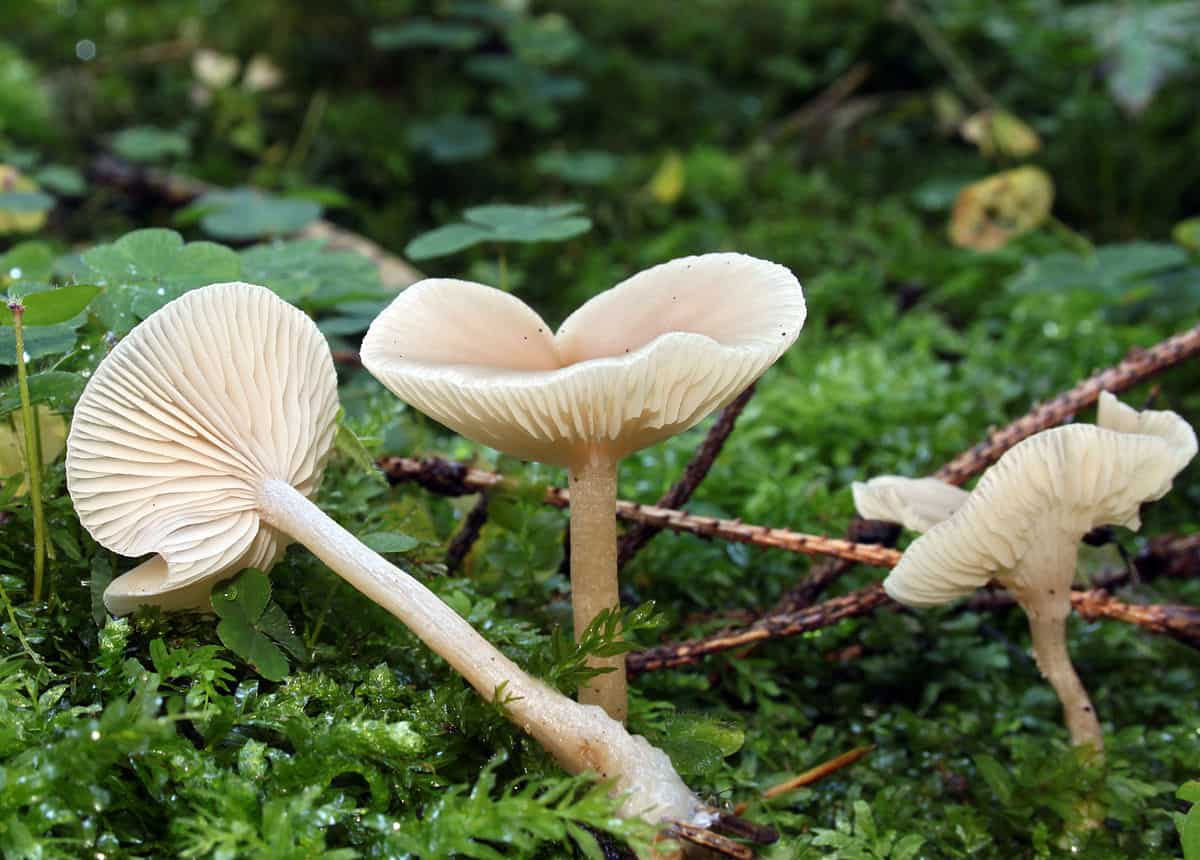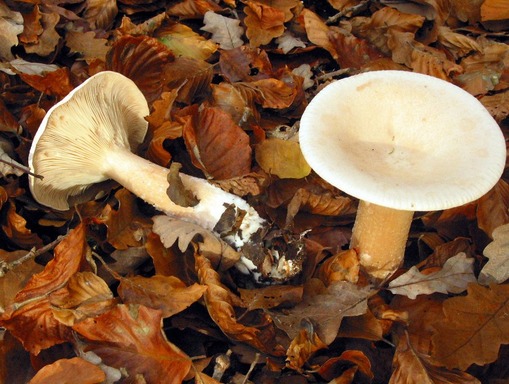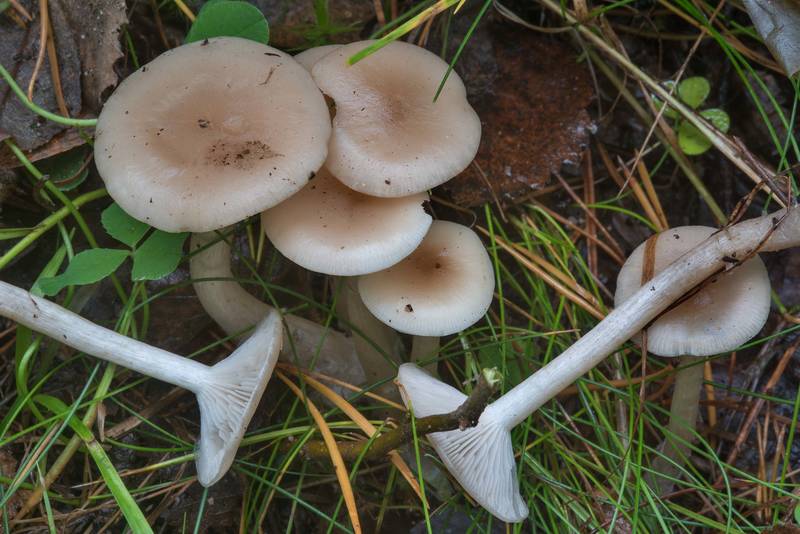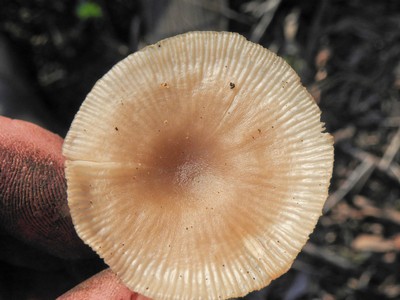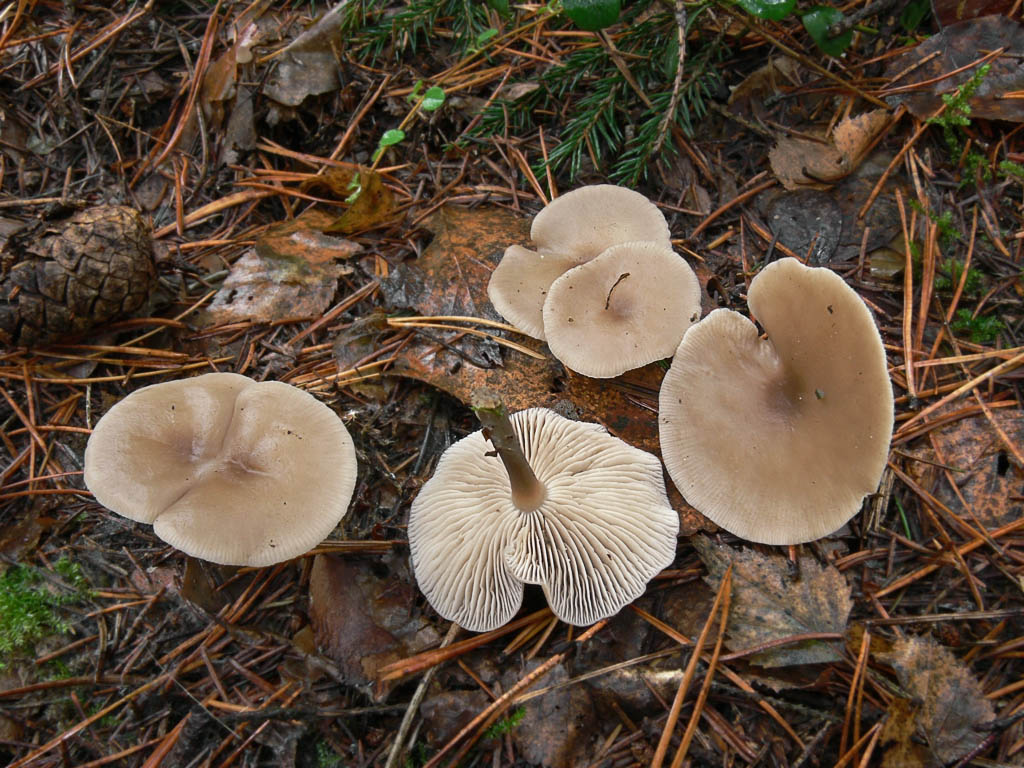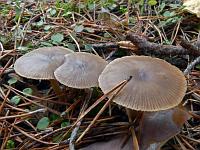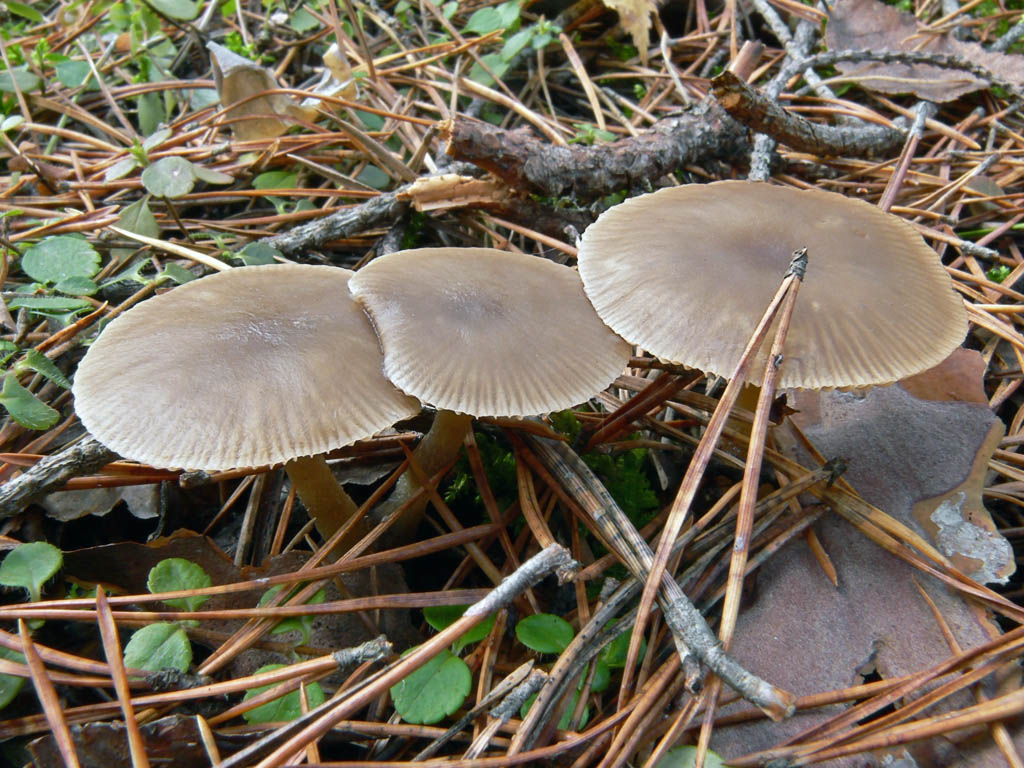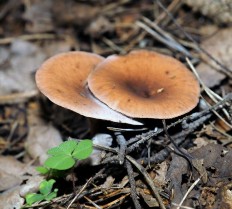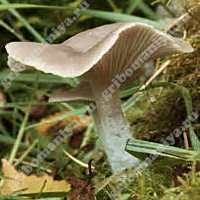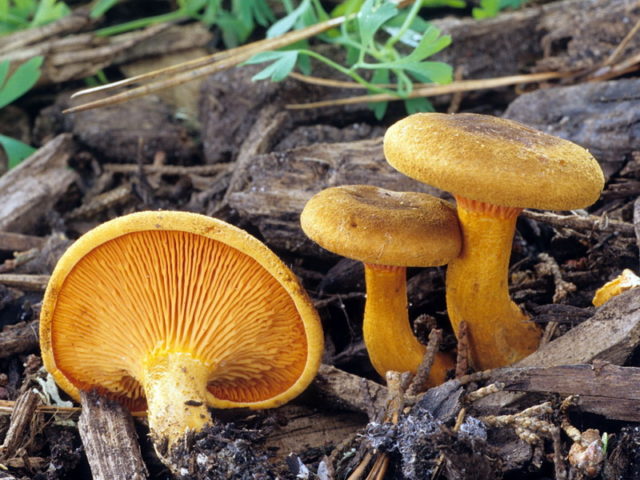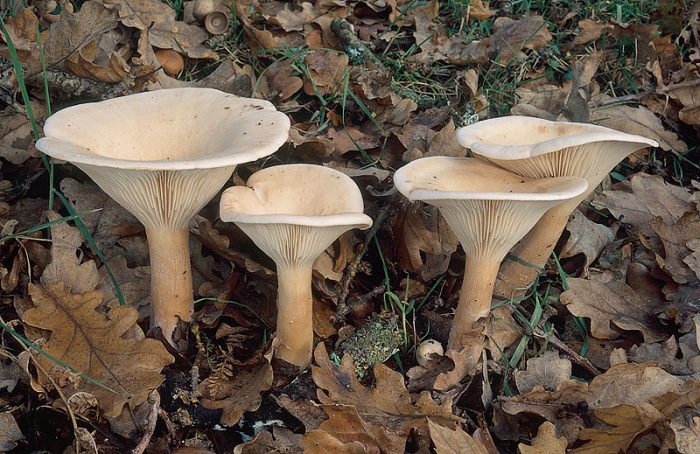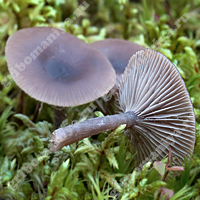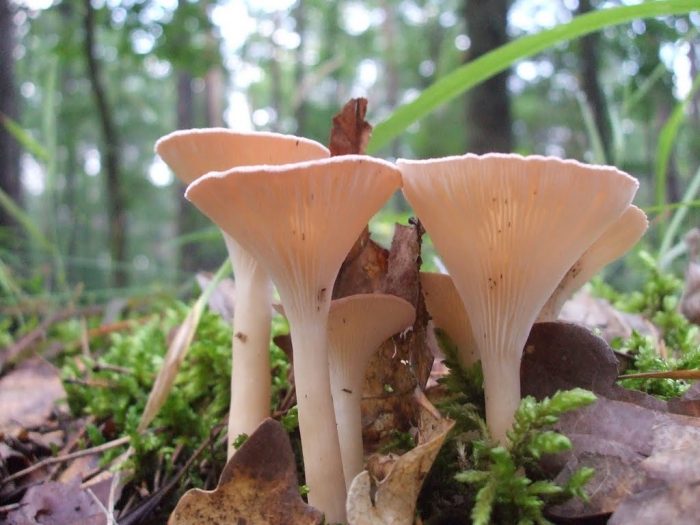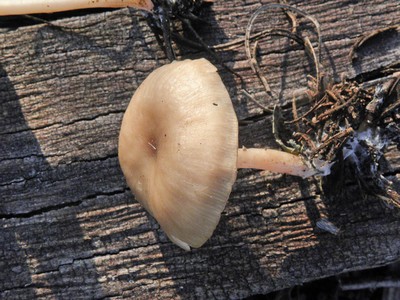Growing at home and in the country
Nobody is engaged in the cultivation of the orange talker, since there is no particular sense in this. It is easier to collect it in the forest, and if you grow mushrooms, then other species with a higher nutritional value and yield are preferable. Nevertheless, if you want to try to cultivate kokoschka at home, then this is quite possible. The technology of this process is simple, since the fungus forms mycorrhiza with various tree species. The govorushka mycelium must be planted during the growing season from May to September. Several holes are dug under the trees, 20 cm deep and 10-15 cm wide and half filled with a substrate. The mycelium is laid in the holes and covered with soil. From above, the planting is covered with rotten leaves or moss. The first harvest will be in a year. Up to 17 fruit chalk can be harvested from one hole per season.
Description of grooved talker
It is quite difficult to determine the grooved govorushka, since its color changes depending on humidity. These mushrooms strongly absorb moisture from the environment. The hat is 1.5-5 centimeters in diameter. The shape of the cap is round, and at the edges it is slightly curved, but after a while the cap becomes concave, while the plates rotate.
The surface of the cap is smooth. The cap is watery, but in dry weather it can wrinkle very much. The color of the cap in sunny weather is light cream, and with humidity it darkens, and the edges become striped.
The plates are narrow, often located. The plates vary in length. The color of the plates is grayish brown. The pulp is grayish brown in color. The consistency of the pulp is somewhat watery with the smell of rancid flour.
The length of the grooved talker leg is 2-8 cm, while its diameter is small - only 0.2-0.7 cm. The structure of the leg vaguely resembles cotton wool. The legs of young mushrooms are covered with a whitish bloom, while the base is slightly pubescent.

The spores of the grooved talker have the shape of an ellipse, their surface is smooth. Whitish spore powder.
Places of growth of grooved talker
Most often, grooved talkers grow in deciduous humus and fallen needles. They can be found in thickets of bushes or in untreated meadows.
They generally prefer dry coniferous forests, although they occasionally come across deciduous forests dominated by birch, beech and oak. In most cases, grooved talkers thrive in poor, slightly acidic soil. They are found in mosses and at the very base of trees.

Growth time of grooved talkers
Grooved talkers grow and bear fruit from the end of September to late autumn, meeting before the first frost, especially if the climate is rather warm and there are no severe frosts. So, until deep winter, these mushrooms can be found in Eurasia. They also grow in the northern regions.
Other mushrooms of this genus
The winter talker has a small hat, the diameter of which does not exceed 5 centimeters, at first its shape is convex, but over time it becomes prostrate and even depressed. The edges of the cap are thin. A bit twisty. The color of the cap is olive-brown or smoky, and when it dries it becomes whitish-brown. The leg is cylindrical in shape, up to 4 centimeters high and about 0.6 centimeters thick. Stem with longitudinal fibers. It is hollow inside. The color of the leg most often coincides with the cap.
I grow winter talkers in coniferous forests, they settle on a litter. These mushrooms ripen in late autumn. They are widespread in the Caucasus, the Far East, Siberia, Europe, as well as Africa and America. These are edible representatives of the genus, which are used in main dishes and soups.

A giant talker, or a giant ryadovka, go giant talker - a large mushroom, the diameter of its cap ranges from 10 to 30 centimeters. The shape of the cap is weakly funnel-shaped. The color of the cap is white and fawn. The leg matches the color of the cap.
There are giant talkers in the forests of Russia. They grow in groups. Sometimes they form "witch circles". This is a conditionally edible mushroom of the 4th category. Only young specimens are used for food, moreover, they are pre-boiled for 15-20 minutes, otherwise an upset stomach may occur.
An orange talker, she is a false chanterelle, she also has a kokoshka a hat with a diameter of 2-5 centimeters. At first, the shape of the cap is convex with curved edges, then it becomes prostrate and depressed, and the edges are thin and straight. The color of the cap varies from light yellow to orange-ocher. The leg is 3-5 centimeters long and 0.5 centimeters in diameter. The leg tapers towards the base. The color of the leg is yellow-orange.
The false chanterelle bears fruit from August to September. These mushrooms grow in mixed and coniferous forests. They can be found on rotting wood, moss, and forest floor. They grow in groups or singly. They are rare, but bear fruit annually. The orange talker is considered an edible mushroom, only hats are suitable for food, and their legs are tough.

Giant talker
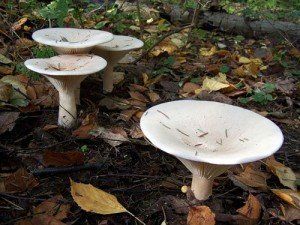
Giant talker (Leucopaxillus giganteus) - this mushroom is considered conditionally edible in the 4th category. Salting of these mushrooms is popular. Moreover, they are delicious and fresh. Mature ones have a slightly bitter taste, so they are either dried or boiled before cooking. Young mushrooms can be dried; after boiling, they are eaten salted and boiled. This type of mushroom belongs to the genus Leucopaxillus and is part of the Tricholomataceae family. He is part of the swine family, not talkers. But these two genera belong to the same family. Other names: giant pig, giant white pig, huge leusopaxillus.
Where does it grow?
This mushroom grows in mixed, coniferous and deciduous forests. Also found in pastures, glades and forest edges. They are collected in the Caucasus and in the European part of Russia. Basically, these mushrooms can be found in large numbers, as they grow in groups.
Every year a giant talker is able to provide a large harvest, but at the same time, the mushroom picker does not meet them too often. When growing, the giant talker mainly makes up "witch's rings". It is possible to collect these mushrooms from August to October. Young mushrooms have protruding-convex caps with a depression in the center. Over time, the caps transform into funnel-shaped with a thin edge bent downward. The shades of the caps are usually yellowish, creamy, snow-white, sometimes taking on a “coffee with milk” shade. The size of the mushroom cap reaches 10-15 cm and even up to 30 cm in diameter. The pulp has a flour smell, there is practically no taste. It is dense and white in color. The plates descend to the stem, being descending. They are narrow, light ocher shade, densely located. The leg is white, up to 4 cm wide and 8 cm long. This mushroom is conditionally edible, and for this reason it should be boiled first, and only then start cooking. The pulp of the mushroom contains: clithocybin A and B and an antibiotic that destroys the tubercle bacillus. Cliptobicin is extracted from mushrooms, which is an antimicrobial agent used to cure tuberculosis of bones and skin. A useful property of this mushroom lies in the fact that physiologically active elements are found in the giant talker, which are used as producers of growth and antibiotic substances. Talkers are useful for the body, as they provide the prevention of infectious diseases. Digestion is improved thanks to enzymes by which the human body gets rid of toxins and the functioning of the stomach is improved.In addition, talkers reduce the amount of cholesterol in the blood. In folk medicine, they are used to treat urolithiasis and respiratory diseases, as well as to heal wounds (ointments and decoctions). Contraindications: there is information that when a person is combined with talkers with alcohol, poisoning of the body may occur.
Recipes
The talkers should be boiled before salting, drying or pickling. In the marinating process, a strong marinade with acetic acid and sterile dishes are used. These mushrooms are best eaten with fried and boiled vegetables. For salting, take young mushrooms, which first need to be boiled for twenty minutes.
- Vinaigrette with talkers Boil beets, potatoes and carrots and cut into cubes. Then mix all these ingredients with pickled mushrooms, fresh onions and canned peas. Season with salt, lemon juice or sunflower oil.
- Pickled salad Pickled talkers are mixed with pickled or pickled cucumbers, seasoned with salt, olive or sunflower oil. You can also add spices, pickled garlic and cold boiled potatoes.
Funnel talker
Funnel talker (Clitocybe gibba) - Latin name. This species is part of the Clitocybe genus of the Tricholomataceae or Tricholomovy family. Other names: funnel mushroom, hare ears, funnel-shaped talker.
Similar species
When the mushroom is already an adult, it is almost impossible to confuse it with other types of mushrooms. But at the same time, some mushroom pickers believe that if the mushroom is light, then it looks almost like a poisonous whitish talker (Clitocybe dealbata).
Description
In young mushrooms, the cap is initially distinguished by its matched edges and bulge. Over time, the shape becomes goblet, noticeably funnel-shaped. A hat with a diameter of four to eight cm. Shade of a hat: grayish-yellow, fawn. She is leathery. Thick pulp is observed only in the center, and so it is thin, dry, white with a recognizable smell. The plates are descending along the pedicle, white and frequent. White spore powder. The leg reaches a diameter of one cm, and is 3-7 cm long. It becomes thicker towards the base, is solid, elastic-flexible, fibrous. She has the same shade as the hat, or it can be lighter. Quite often, a special fluff from hyphae covers it near the base.
Sprouting
The funnel-shaped talker can be encountered by mushroom pickers near the paths, in the most different forests. Quite often, these mushrooms grow in large numbers in groups. Prefers to grow in litter, but rather shallow. Can be harvested from mid-July to late September. Prefers shrubs, mixed and deciduous forests, pastures. Mushroom pickers can meet the funnel-shaped talker in the North Caucasus, Western Siberia, and the European part of Russia. Belongs to the fourth category, edible mushroom species. For cooking, you only need mushroom caps, which can be dried, salted, boiled. Initially, you need to boil the mushroom, and pour the broth.
Composition
Mushrooms such as govorushki contain nebulin (antimicrobial substance). It is not as active as the antibiotic clitobicin, but it is similar in its properties. In this case, side effects are not observed during treatment. An aqueous extract of these fungi is often used to heal patients with wound microflora. The effect of the extract resembles the effect of well-known antibiotics: biomycin, streptomycin, levomycin.
Contraindications
Should be eaten with care so as not to be confused with other mushrooms. In various literature, it is allowed to eat, for example, from the age of twelve
Recipes
The funnel-shaped talker is cleaned of debris before cooking, damaged parts are cut off. Then warm water is taken and the mushrooms are washed well with it. To soak them, they are left in water for ten minutes and then dried.Boil without fail before pickling or pickling. For pickling, a strong marinade with acetic acid is taken. The dishes must be sterile. They are used for food only after they have been boiled for twenty minutes. Then you can put these mushrooms in main courses or soups.
- Vegetable saute with talkers Eggplant or zucchini, peppers, potatoes, onions and tomatoes should be stewed for fifteen minutes. After that, boil the talkers and add together with bay leaves, pepper, salt. From time to time during the cooking process you need to add water. Bring to readiness.
- Risotto with talkers Canned peas, stewed vegetables and corn should be fried along with boiled mushrooms. Boiled rice and sunflower oil should be added after the liquid has evaporated. Fry for five or seven minutes, seasoning to taste.
- Salting Mushrooms are soaked, washed, scraped off forest dirt. Hot and cold pickling can be used.
Monolithic foundation concrete
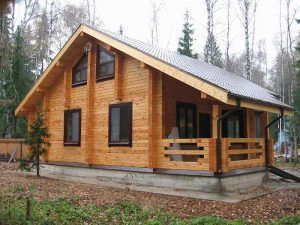 When choosing a grade of concrete, you must rely on the weight of the future home
When choosing a grade of concrete, you must rely on the weight of the future home
However, this is far from the case - the choice of a particular type of concrete is influenced by a number of factors:
- Features of the soil of the site: the level of groundwater, the depth of freezing, etc.
- The design and type of the future foundation: monolithic, in the form of brickwork, from FBS blocks.
- Dimensions of the future home. The higher the specific gravity of the structure, the higher the strength of the concrete base should be.
For example, to fill a strip or columnar foundation, you need a mixture that includes cement, crushed stone (gravel), sand and water. This is a concrete solution of the M300 or M400 brand - the exact proportions for the preparation of such a mixture are regulated by the building codes SNiP.
To make a brick base, a common masonry mortar is used. It can also be used for the installation of foundation blocks. However, in the latter case, the so-called "lean concrete" is often used. It got its name because of the small proportion of cement in the total volume of the concrete mixture.
Of course, the easiest way out is to order ready-made concrete, produced in accordance with all standards at a concrete-mortar unit. But not everyone will have such an option - first of all, because of its high cost. Therefore, most private developers prefer to make concrete for pouring the foundation with their own hands.
To get quality concrete that can last for decades, you need to use quality ingredients mixed in the right proportions.
The main components of concrete for a monolithic foundation, calculated for 10 kg of cement (in accordance with the requirements of SNiP):
- Binder: cement grade 300 or 400 - 10 kg. It is not advisable to use cement grade 500. First, its cost is much higher; secondly, the difference in technical characteristics does not play a decisive role in this case.
- Fine-grained filler: sand - 30 kg. It can be both riverine and quarry crumb (screenings). The content of organic impurities in the composition of the concrete mixture - earth, silt, is unacceptable. This significantly reduces its quality.
- Coarse-grained filler: crushed stone or gravel - 50 kg. It is permissible to replace them with washed pebbles, but this also somewhat reduces the quality of the solution. The fact is that a smooth pebble surface has a worse adhesion coefficient with binding components.
- Water. It is recommended to use clean water, in an amount half the weight of the total weight of dry components (cement, sand and gravel). If the concrete turns out to be too thick, the percentage of water should be slightly increased. Excessively hard concrete during pouring does not fill the entire space of the formwork, leaving "sinks". It should also be borne in mind that the sand in its composition already contains a certain amount of water.
In addition to the above main components, plasticizers and antifreeze additives are also added to the composition of monolithic concrete. They significantly improve its quality, and also allow work at low temperatures.
Development of a pit.
1. Accidental digging of soil during the development of a foundation pit or trench in some places should be filled with the same soil, brought to its natural density.
2. In order to prevent the foundation soil from eroding, softening and reducing its bearing capacity, prior to the construction of the foundations, work must be performed to divert surface and groundwater from the pit (open drainage or drainage, dewatering, etc.).
3. As a rule, a break between the end of the excavation and the foundation is not allowed. In case of forced breaks, measures must be taken to preserve the natural properties of the base soil.
Mortar for brick foundations
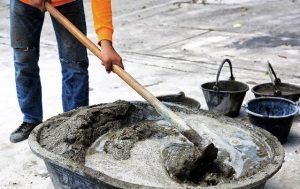 For filling the bases, cement mortar is used.
For filling the bases, cement mortar is used.
Masonry mortar can be of several types:
- lime;
- cement-lime;
- cement.
Lime
It is quite simple to make such a solution - no cement is required for its preparation. It contains sifted sand and slaked lime in proportions of 3 to 1. However, such a composition is much inferior in strength to cement ones. Therefore, it is not recommended to use it for building a foundation.
In addition to lime and sand, it also includes cement. In this case, the lime is soaked to obtain milk of lime. On it, you should knead a dry mixture of sand and cement, bringing it to the consistency of a thick dough. Lime makes the solution much more flexible and easier to use.
But at the same time, it somewhat reduces the strength indicators. Therefore, cement-lime mortar is not used for laying the bearing elements of the foundation. As a rule, it is used when filling the openings of columnar or pile foundations with bricks.
Cement
This is the most durable type of masonry mortar widely used in construction. To prepare it, you will need cement, cleaned sand or building chips (screenings) and water. The proportions of the dry mix may vary depending on which brand of solution is to be prepared. So, for grade 50, cement and sand are taken in a ratio of 1 to 6.
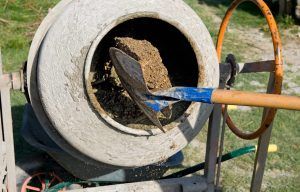
Watch a video on how to properly make concrete for its further pouring with your own hands.
"Skinny" concrete
Another common type of foundations, often used in the construction of both large objects and private houses, is block foundations. It is mounted from standard FBS concrete blocks, fastened together with cement mortar. The blocks are laid on a sand or gravel pad, which is often held together with so-called "skinny" concrete. They also often fasten concrete blocks, sealing the end holes of adjacent blocks.
A feature of "lean" concrete is a significant reduction in the proportions of water and cement in the total mass of the mortar. Because of this feature, this type of foundation solution got its name. The "lean" concrete is used where the indicators of the strength of the coupling are not so critical. This allows significant savings during construction on the most expensive component of concrete - cement.



